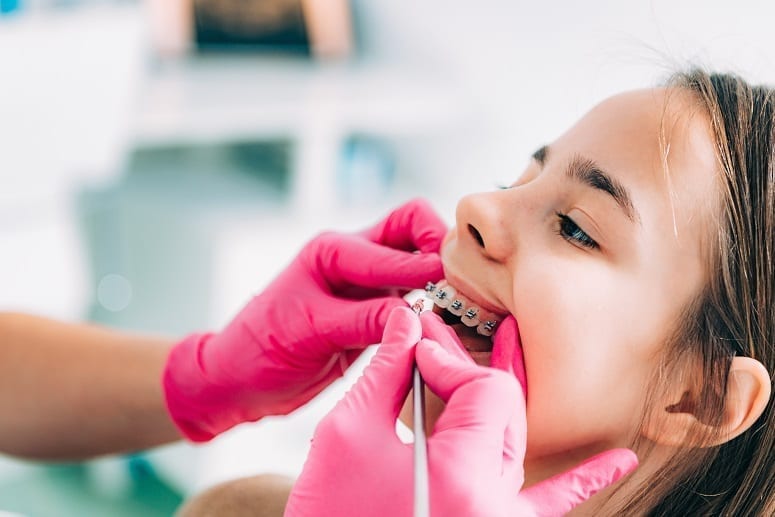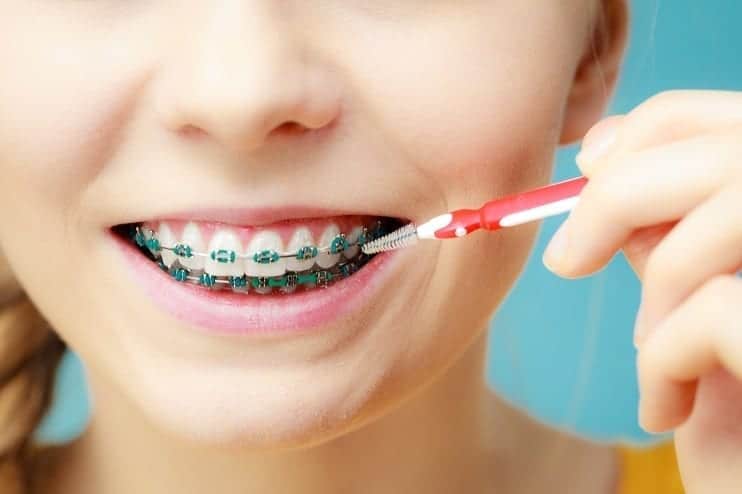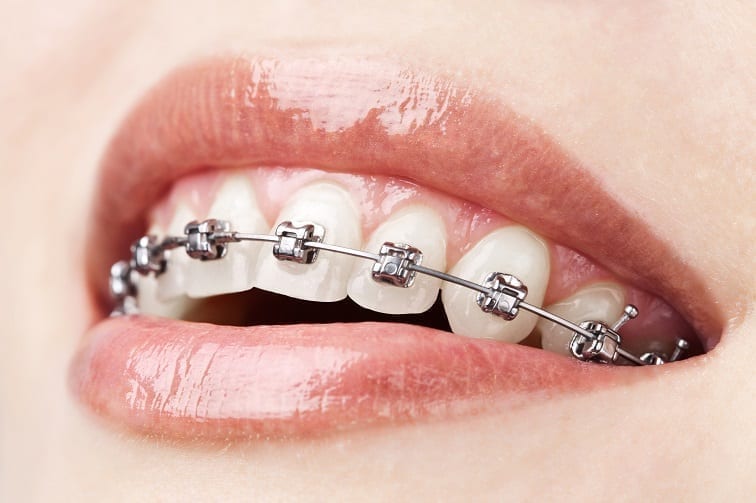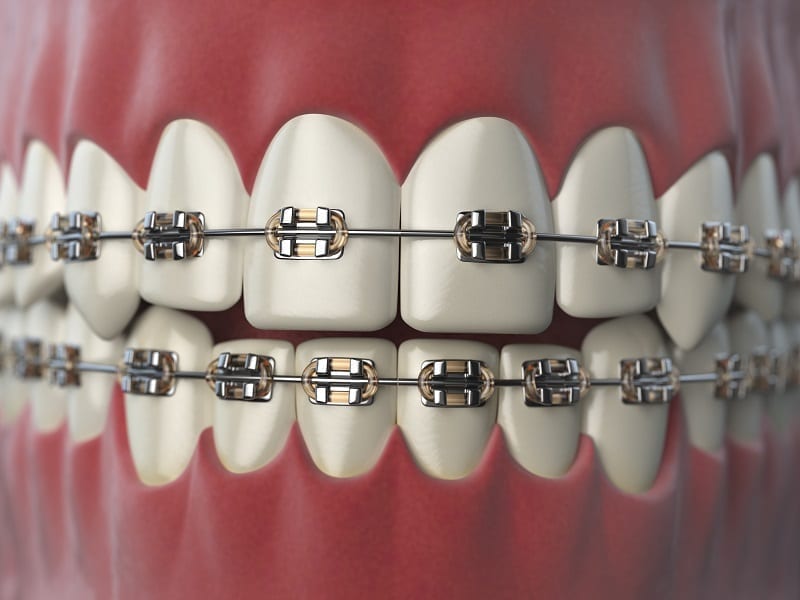Braces are orthodontic or dental devices responsible for straightening crooked teeth or malocclusion for the most part. They can make your teeth align so you won’t have a prominent underbite, scissor-bite, or overbite.
Braces are placed in such a way that’s most pleasing to the eyes. They are recommended to people who have overcrowded teeth, misplaced teeth, uneven teeth, or any set of teeth that’s not functionally well and/or aesthetically pleasing.
Braces work by taking advantage of the teeth’s ability to shift and move whenever there’s a gap present. It uses pressure applied continuously to each individual tooth to accomplish this task. As the teeth move, the bone changes shape while pressure is being applied. Teeth placement in the mouth is more malleable than you think.
Page Contents
Who Should Undergo and Expected Results

Braces wrap around every tooth to provide as anchor for the brackets that in turn dictate the new shape your mouth should be in when all is said and done. The device should be used for people who have the following conditions or issues because the orthodontic device is highly beneficial in fixing such maladies.
- Overbite
- Open bite
- Underbite
- Deep bite
- Reverse bite
- Crooked teeth
- Jaw problems
- Overcrowded teeth
- Misaligned or asymmetrical teeth
Additionally, the patients who need orthodontic brace treatment can pick from the following different brace options or types.
Types and Prices of Braces Chart

Here are the types of braces available and their respective prices. The last column shows the prices available only at Thantakit Clinic, which is significantly cheaper than regular stateside dental prices more often than not.
| TYPES OF BRACES | REGULAR PRICES | THANTAKIT PRICES |
|---|---|---|
| Metal Braces | $3,000 to $7,000 | ฿50,000 to ฿80,000 ($1,650 to $2,640) |
| Ceramic Braces | $4,000 to $8,000 | ฿80,000 to ฿120,000 ($2,640 to $3,960) |
| Speed Braces | $4,000 to $6,000 | ฿100,000 to ฿160,000 ($3,300 to $5,280) |
| Invisalign | $4,000 to $9,000 | ฿100,000 to ฿250,000 ($3,300 to $8,250) |
| Retainers (Each Arch) | $500 to $1,000 | ฿5,000 ($165) |
What Are Metal Braces?

Traditional metal braces and their metal brackets are what most of us visualize when we think about “braces”. It’s often linked with children who have rich parents or nerds. However, the so-called “brace face” look remains a common sight because when push comes to shove, the orthodontic treatment remains extremely effective if a bit aesthetically unpleasant while the metal braces are present.
- Notable Modern Improvements: These braces can straighten your teeth out from 6 months to 2 years. However, rom the 1970s to the 1990s, metal braces were much more cumbersome and aesthetically unpleasant. It gave you an ugly “metal mouth” with its brackets. It’s still being portrayed as such by the Hollywood entertainment industry and pop culture. However, these versions of the metal braces have long been replaced with smaller, less noticeable braces that have improved beauty and dental camouflage.
- Heat-Activated Archwires: The metal braces from the New Millennium and onwards now come with heat-activated archwires. They use the internal heat of your body or mouth to keep your teeth moving towards the proper place as indicated by the bracket placement done by your orthodontist. This makes the whole braces experience faster and more bearable to the Millennial and Generation Z youth compared to the more “hardcore” braces of the past.
- Pros and Cons: Metal braces, even the latest ones, remain the more visible yet least costly type of braces available. Children with metal braces can get colored bands in order to customize and express themselves through braces customization. However, because they’re the most noticeable braces, you’ll have to deal with a compromised smile until you’re in need to take them out. They’ll sabotage your dental appearance even though they’re there to adjust your bite and look in the long term.
What Are Ceramic Braces?
Ceramic braces are among many braces variants that try to solve the aesthetic disparity caused by metal braces. Even though they have the same size and shape of metal braces, they feature tooth-colored or clear brackets that blend or camouflage themselves better with the underlying teeth themselves compared to the more obvious and metallic look of their metal counterparts. Moreover, there are ceramic braces that make use of tooth-colored wires to completely hide them from immediate recognition.
- Less Visibility: People are resistant to using braces because it looks obvious when they wear them, especially metal ones. They are obvious-looking and obtrusive. Children who wear them get teased a lot or called names like “Nerd!” Ceramic braces are less noticeable and more hidden than the “brace face” look of metal braces at the very least. They can also move teeth faster than Invisalign. They offer metal brace effectiveness while being partly unnoticeable a la Invisalign.
- Staining and Dental Hygiene Issues: Ceramic tooth-colored brackets have issues with staining exactly because they’re tooth-colored. Their metallic counterparts don’t stain as easily. It’s tough enough to brush your teeth with metal braces, so it’s even tougher to do so with brackets since they stain if you don’t care for them more carefully.
- Shorter Length of Time: It takes 18 months to 36 months or 1½ years to 3 years for a set of ceramic braces to straighten your teeth out. This is as opposed to the 6 months to 24 months or ½ a year to 2 years of straightening that metal braces can do. It takes 12 months and beyond of Invisalign to align your teeth to orthodontic straightness, even in teeth that only require slight correction and will take only half that time to get straightened by metal braces.
What Are Speed Braces?
30 years ago, speed braces were invented. These braces have friction-free brackets that are “self-ligating”. What this means is that the braces allow your dentist to move your teeth and occlusion around in a properly speedy and efficient manner compared to metal and ceramic braces. Self-ligating braces work by incorporating spring clips with its bracket design to secure the wires into the brackets to quickly and properly shift your teeth into place with just the right amount of brace pressure.
- A Third Smaller Than Regular Braces: Compared to regular ceramic or metallic braces, speed braces are a third smaller or 30 percent smaller than them. This gives you quicker treatment to boot compared to the long-term requirements of Invisalign. Its clips guarantee a more efficient treatment that saves you time yet can cost as much or less than the ceramic braces price range.
- Extremely Light Forces: The springs are designed in such a way that they can maximize extremely light forces to shift and move teeth. The gums of your mouth and other soft tissue will be less prone to swelling, pain, and irritation with speed braces. Additionally, they correct malocclusion of not only the teeth but also the jaw using effective use of pressure. Dental shifting is applied at a controlled manner for a slightly higher cost.
- Shorter Treatment Times: As their name suggest, speed braces are renowned for their speediness or shorter treatment times. This is because they have fewer soft tissue complications, smooth and rounded bracket design, and friction-free brackets with controlled light forces to move your teeth to proper locations. It only takes 3 to 6 months or not even a year for the self-ligating braces to do their job. They’re thus more expensive but ironically ceramic has a higher price range.
What Is Invisalign?
The main claim to fame of the Invisalign brand is, like their name suggests, align your teeth while being practically invisible. They specifically use 18 to 30 tailor-made clear plastic aligners to align your teeth without looking like your traditional metal or even ceramic braces. However, they have their own respective pros and cons, such as requiring replacement every 2 weeks for best results even though they’re removable.
- Almost Invisible: Invisalign is unobtrusive because they’re clear plastic aligners. It takes more than a glance but an outright special inspection for someone in front of you to notice that you’re wearing these “invisible” or “barely visible” dental appliances. It has a price point similar to speed braces but for different reasons altogether. Its price cap, however, is even higher than that of ceramic braces, making them the most expensive braces.
- Limitations with Certain Issues: Invisalign is less effective than metal braces when it comes to solving severe malocclusion such as having the underbite of a piranha or the overbite of a rodent. Invisalign, despite is expensiveness, is mostly used for slight correction of dental issues. You have to pay quite a lot to maintain these tailor-made clear braces while metal braces cost about $1,000 less or more depending on your dental service provider. It takes 12 months or more to get results from Invisalign.
- Only for Teens and Adults: Children cannot use Invisalign. They have to go with metal or ceramic braces at best. Maybe even retainers. Invisalign is only recommended for use by teenagers and adults. Children should not wear these appliances. It’s the most expensive braces option available and it’s removable. It’s not uncommon for children to lose these braces for whatever reason, which can be costly to replace when push comes to shove. At least metal braces are firmly attached to the teeth.
What Are Retainers?

As its name suggests, a retainer is a non-brace method of retaining a certain mouth or bite shape that’s also less severe than its braces counterparts. This orthodontic device can be considered the lighter version of braces. It helps maintain the shape of your teeth that the braces have already straightened out. This thin wire is worn across the back of the lower or upper front teeth. It’s a good method of keeping your teeth from reverting to the original malocclusion you were born with, which sabotages all that time you spent wearing braces in the first place.
- Why Wear a Retainer? You should wear your retainer as the last phase of your orthodontics treatment that began with you wearing braces. After braces removal, the device serves as a method of retaining the shape you’ve gotten, to prevent teeth from shifting back to their original malocclusion positions. Wearing the retainer overnight or much longer can help maintain teeth straightness until your orthodontist approves of you stopping your retainer treatment.
- Fixed Retainers: There are two types of retainers. The first is the fixed retainer. It involves applying a thin wire you’re supposed to wear on your front teeth from your upper or lower jaw. It’s set into place with dental cement. It’s the same cement used to apply braces brackets. Once the retainer is bonded with your teeth, you’ll have to adjust how you floss or brush your teeth. You’ll need a floss threader to clean these teeth out the same way you would clean a dental bridge with crowns right above the gum line.
- Removable Retainers: Pop culture media has familiarized many people with the removable retainer. It’s the same thin wire you’re supposed to also wear on your front teeth, but this time it’s not cemented or bonded unto them. It serves the same purpose but it comes with the convenience of being removable. This way, you don’t have to change much in your tooth-brushing and flossing routine. The way it’s held into place is with clasps or hooks combined with acrylic material you can insert in and around the back teeth to hold the whole contraption into place. You also need to regularly wash the retainer itself.
The Bottom Line

Braces are the orthodontic solution you can depend on when it comes to improving your facial appearance and bite. It also makes dental hygiene and oral maintenance easier to deal with down the line as your teeth slowly but surely straighten themselves out. As such, they can assist patients in gaining, regaining, or maintaining good dental health for the long term. With that said, you should give Thantakit Clinic at Thailand a try. Their international dental center offers all the brace types seen here at the fraction of the price of your local dental clinic.
In many ways, Thailand healthcare and dental care is better and more affordable than what’s available in first-world countries like the U.S., the U.K., Canada, E.U., Australia, and so forth. Many citizens of Europe, North America, and Australia travel all the way to Asia or Thailand to get cost-effective orthodontic treatment because even when you take travel expenses into consideration, it’s still much cheaper than stateside treatment.
Thantakit International Dental Center is Thailand’s longest established dental center. Situated in Bangkok, our clinic is renowned across the world as a destination for world-class dentistry, with most of our patients flying to us from Australia.
Please contact us today and get a FREE dental consultation.












